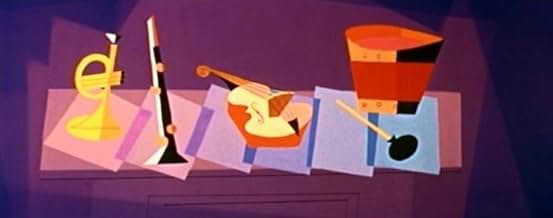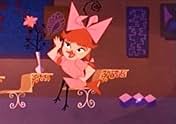NOTE IMDb
7,1/10
1,6 k
MA NOTE
Ajouter une intrigue dans votre langueA crash course on the history of Western musical instruments.A crash course on the history of Western musical instruments.A crash course on the history of Western musical instruments.
- Réalisation
- Scénario
- Casting principal
- Récompensé par 1 Oscar
- 2 victoires au total
The Mellowmen Quartet
- Singing Group
- (voix)
- (non crédité)
Loulie Jean Norman
- Penelope Pinfeather
- (voix)
- (non crédité)
Charlie Parlota
- Chorus Singer
- (voix)
- (non crédité)
Bill Thompson
- Professor Owl
- (voix)
- (non crédité)
- …
Gloria Wood
- Suzy Sparrow
- (voix)
- (non crédité)
Avis à la une
As I said above, I really wanted to hate this film...but I couldn't. The reason I wanted to give this film a savage review is that it represents a style of animation that I hate--the very modern and minimalistic animation that came into vogue in the 1950s and lasted through the 70s. Up until films like TOOT WHISTLE PLUNK AND BOOK and films by (uggh) UPA Studios, animation had been very detailed and higher quality. Gorgeous backgrounds and high frame-rates were the norm in the 40s and into the 50s with studios like Looney Tunes, MGM and Disney. But, with the success of very simplistic UPA films like Gerald McBoing-Boing and Mr. Magoo (beating out traditional films for Oscars AND costing a fraction to make), Disney decided to experiment with this splashier but tremendously easy style of animation. So, for the style of this film and what it represented, I wanted to hate the film.
The problem is that although I disliked the art, I couldn't help but like the film--even though it was quite educational. In fact, now that I finished the film, I am still amazed because I usually watch animation to have fun--not learn things! But, I found that I enjoyed the learning.
The film is about the basic parts of music and how all instruments fall within four broad categories--those that go 'toot', those that whistle, those that are plucked ('plunk') and those that are struck ('boom'). This may seem silly, but it really did make sense and made me understand and appreciate music a lot more. In particular, I learned why horns are all curvy and how a trumpet works--and that's really cool.
Overall, a great film to teach anyone (not just kids) about the fundamentals of music AND it does it in a way that isn't boring. Who would have thought this was possible?!
The problem is that although I disliked the art, I couldn't help but like the film--even though it was quite educational. In fact, now that I finished the film, I am still amazed because I usually watch animation to have fun--not learn things! But, I found that I enjoyed the learning.
The film is about the basic parts of music and how all instruments fall within four broad categories--those that go 'toot', those that whistle, those that are plucked ('plunk') and those that are struck ('boom'). This may seem silly, but it really did make sense and made me understand and appreciate music a lot more. In particular, I learned why horns are all curvy and how a trumpet works--and that's really cool.
Overall, a great film to teach anyone (not just kids) about the fundamentals of music AND it does it in a way that isn't boring. Who would have thought this was possible?!
Oh! It's one of them "educational" films. This is a masterful look at the dynamics and science of musical instruments. It gives a rudimentary history of all things instrumental. The four words in the title refer to horns, wood winds, strings, and percussion, the four sections of the orchestra. It is done in a fun and visually interesting way. I recall seeing "Donald Duck in Mathemagic Land," in my math classes, an excellent teaching tool created by the Disney animators. The only part I had trouble with was that chorus of birds singing in the Andrews Sisters style. Many of the Dr. Seuss cartoons used this choral style and it becomes pretty tiresome at times. But it needed narration and this is they way they got it.
We join Professor Owl as he teaches his avian students about where all the music comes from - in other words, the whole TOOT WHISTLE PLUNK AND BOOM of the matter.
This very engaging cartoon gives a lighthearted look at the origin of musical instruments. Using humor as the best tool to teach - in this instance zany cavemen bang home the lessons - it leaves the viewer with several pertinent facts from the fascinating world of musical history.
TOOT WHISTLE PLUNK AND BOOM was the Disney Studio's first foray into stylized, or limited, animation. The result was very successful & the 1953 Oscar for best cartoon was the reward.
This very engaging cartoon gives a lighthearted look at the origin of musical instruments. Using humor as the best tool to teach - in this instance zany cavemen bang home the lessons - it leaves the viewer with several pertinent facts from the fascinating world of musical history.
TOOT WHISTLE PLUNK AND BOOM was the Disney Studio's first foray into stylized, or limited, animation. The result was very successful & the 1953 Oscar for best cartoon was the reward.
If you think that Disney animators were only good at drawing cutesy animals in the 1950's then you need to see this film. The animation style is like nothing you've ever seen in a Disney film. While it does have its share of cute animals (the setting is a classroom full of birds), many of the characters are strange, geometric looking creations. I especially enjoyed the ancient Egyptian characters modeled after ancient Egyptian art. This is an educational short on the origins of music, but also works as a great comedy. The "Plunk" section is the best! It's a one joke bit, but it never gets old.
I must have seen this half a dozen times in elementary school in the 70s, but had not seen it since. I remember enjoying it, and, as a musician, I have thought of it many times.
I watched this again recently, and it's really a gem, except for the unfortunate racial stereotypes. We see clownish caricatures of Chinese, and we see a quartet of black-faced minstrel players.
The few cringey moments were disappointing, but it was 1953, and sensibilities were different. That doesn't excuse it or explain it, but I'm not going to 'cancel' Disney or even this one film because of it. Who knows how our current society will be judged in 70 years? That said, I understand why this wasn't included in the offerings provided by Disney+.
The animation is refreshingly different than other projects coming out of Disney in the early 50s. The music is great, and it's a great lesson in musical instrument families (even if they did put the piano in the string section).
Watch it. Enjoy it. Remember times were different then. Remember your history and how far we've come, and how far we have to go.
I watched this again recently, and it's really a gem, except for the unfortunate racial stereotypes. We see clownish caricatures of Chinese, and we see a quartet of black-faced minstrel players.
The few cringey moments were disappointing, but it was 1953, and sensibilities were different. That doesn't excuse it or explain it, but I'm not going to 'cancel' Disney or even this one film because of it. Who knows how our current society will be judged in 70 years? That said, I understand why this wasn't included in the offerings provided by Disney+.
The animation is refreshingly different than other projects coming out of Disney in the early 50s. The music is great, and it's a great lesson in musical instrument families (even if they did put the piano in the string section).
Watch it. Enjoy it. Remember times were different then. Remember your history and how far we've come, and how far we have to go.
Le saviez-vous
- AnecdotesThis was the first animated cartoon in CinemaScope.
- Citations
Owl: Today we're going to study about...
Boy bird: [looking at a comic book] Ancient history?
Susy Sparrow: Love and mystery?
Penelope Pinfeather: [writing on the blackboard] Mathematics?
Twin brothers: [balancing other students on their heads] Acrobatics?
Students: Readin', spellin'...
Bertie Birdbrain: Storytellin'?
Owl: No, no, no!
[bops Bertie on the head]
Owl: The study of musical instruments is the subject for today.
The Canary Sisters: [singing] The study of musical instruments is the subject for today!
- Versions alternativesBlack stereotypes have been cut from this short on the DVD version.
- Bandes originalesA Toot And A Whistle And A Plunk And A Boom
Written by Sonny Burke & Jack Elliott
Meilleurs choix
Connectez-vous pour évaluer et suivre la liste de favoris afin de recevoir des recommandations personnalisées
Détails
- Durée10 minutes
- Rapport de forme
- 2.35 : 1
Contribuer à cette page
Suggérer une modification ou ajouter du contenu manquant

Lacune principale
By what name was Les Instruments de musique (1953) officially released in Canada in English?
Répondre


















